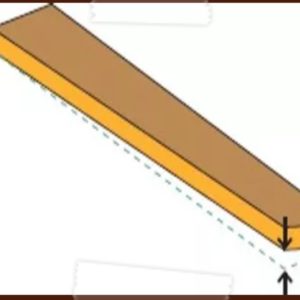How can you straighten pine wood, twisted in a spiral shape, without using a brush? Thank you
Discussion Forum
Get It All!
UNLIMITED Membership is like taking a master class in woodworking for less than $10 a month.
Start Your Free TrialCategories
Discussion Forum
Digital Plans Library
Member exclusive! – Plans for everyone – from beginners to experts – right at your fingertips.
Highlights
-
Shape Your Skills
when you sign up for our emails
This site is protected by reCAPTCHA and the Google Privacy Policy and Terms of Service apply. -
 Shop Talk Live Podcast
Shop Talk Live Podcast -
 Our favorite articles and videos
Our favorite articles and videos -
E-Learning Courses from Fine Woodworking
-
-













Replies
If it's twisted badly enough, my fire pit does a great job of straightening it.
It's best to not buy twisted boards.
If the board is 6 feet, and you need three footers, cut them to just over final length if you can. Half the twist is gone!
I can't say much more without knowing what kinds of tools you have available.
Tell it to stop being silly, pull it socks up and stand up straight! It won't listen, of course. Why, even waving your brush at it just resulted in more dumb insolence I bet.
That twist in planks is called wind (as in what you do to a clock, not the air blowing over your ears to make them cold). It winds more (sometimes less) as the moisture content of the plank alters. So a plank initially cut straight in the green goes twisted as it dries out.
You can plane them flat. But just a teeny bit of moisture change will see them wind again, one way or the other, to some degree. Such planks are best avoided when making furniture. (Unless you do post-modern twisted stuff that changes shape every day).
I've read various theories as to what causes the fibres of a tree trunk to wind. Some opine that its caused by the tree trying to follow the sun to gain maximum rays upon not just the leaves on this side but also that, as the sun goes over the sky from dawn to dusk. Such sun following is said to be most prevalent in those trees on the edge of a copse or woodland. There would be no point in a tree mid-forest performing such a pirouette.
But is it true? I don't know. I tried watching a tree for a while to see if it did follow the sun but I fell asleep.......
Here is a chestnut been growing on the edge of a wood for decades. That's wind, that is!
Lataxe
I'd like to hear more about how the brush option works.
Humor aside (although always appreciated) removal of material is your answer. The jointer and planer are a team and fixing the problem you present is their primary job. A hand plane can also get you there.
I’m also not clear on the brush. Maybe a typo?
You could try steam bending.
Mikaol
Here's my two cents. You can't straighten wood. It may be possible with lots of work and equipment, but home woodworkers don't have the equipment or skills to do it. All you can do is cut off the outer parts of the bends and twists and create a thinner straight board. Then you hope it doesn't bend again. Buy the straightest boards you can, let them get acclimated to your shop and start building. Good luck.
You can remove the twist on one side of your board on a jointer and the other side on a planer. It requires some experience even if you have the machines. You may start with a 5/4 board and and up with a 3/8, depending on severity and skill. Machines mimic hand tools, so you can so the same with a scrub plane or a jack plane, but it's a skill-building and muscle-building exercise.
Jfska is right to warn of the difficulty when dealing with twisted timber. Cup removal - easy; as is the elimination of the bow. This is the bulk-work of planer-thicknessers. Use of the machine (or a hand plane if you're a masochist) will reduce the plank thickness - although less waste is necessary if a bowed or cupped plank is cut into smaller (still useful) pieces.
But the twist! As John_C2 notes above, shortening the plank means less twist per part and therefore less waste to get them flat. But twist is notorious for being far more sensitive to moisture changes than are a bit of cup or bow. That twist will come back given the slightest chance offered by a humidity change.
Twist also seems to be less tameable than bow, in that bow can be eliminated by careful inclusion of the bowed piece in the construction. Other straight members of that construction can often hold bow in check. Less so with cup perhaps. Not at all with twist, which will corkscrew a piece in one way or another if it wants to retwist when things get damper or drier.
Timber with wind (twist) in it is best avoided for the great majority of construction purposes, then. It can be hard to reject an otherwise beautiful plank, though.......
Lataxe
This forum post is now archived. Commenting has been disabled